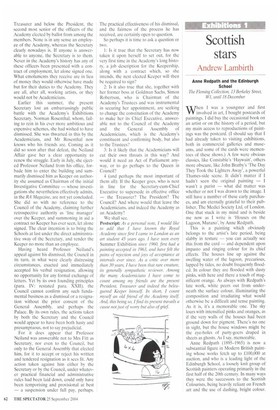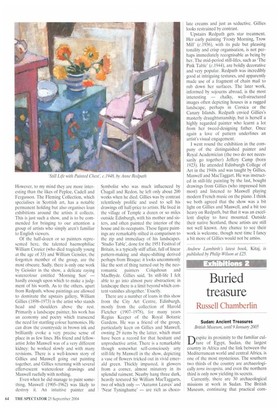Scottish stars
Andrew Lambirth
Anne Redpath and the Edinburgh School The Fleming Collection, 13 Berkeley Street, WI, until 18 December
When I was a youngster and first involved in art, I bought postcards of paintings. I did buy the occasional book on an artist or on the history of a period, but my main access to reproductions of paintings was the postcard. (I should say that I had already taken to visiting exhibitions, both in commercial galleries and museums, and some of the cards were mementoes of these shows.) A few were obvious classics, like Constable's `Haywain', others more obscure, like John Bratby's The Day They Took the Lighters Away', a powerful Thames-side scene. It didn't matter if I hadn't seen the original painting — I wasn't a purist — what did matter was whether or not I was drawn to the image. I still have a number of these early purchases, and am eternally grateful to their publisher, The Medici Society Ltd, of London. One that stuck in my mind and is beside me now as I write is 'Houses on the Lagoon, Murano', by Anne Redpath.
This is a painting which obviously belongs to the artist's late period, being slabby in texture — you can actually see this from the card and dependent upon impasto and ringing colour for its chief effects. The houses line up against the swelling water of the lagoon, precarious, lapped by tides, no doubt frequently flooded. In colour they are flooded with dusty pinks, with here and there a touch of magnificent orange. As always with Redpath's late work, white peers out from underneath the surface colour, illuminating the composition and irradiating what would otherwise be a difficult and tense painting. As it is, it's a memorable one. The sky lours with intensified pinks and oranges, as if the very walls of the houses had been ground down for pigment. There's no one in sight, but the house windows might be the eye-holes of party-goers draped in sheets as ghosts. As I say, memorable.
Anne Redpath (1895-1965) is now a substantial figure in Modern British painting whose works fetch up to £100,000 at auction, and who is a leading light of the Edinburgh School, a loosely knit group of Scottish painters operating primarily in the first half of the 20th century. In many ways they were the successors to the Scottish Colourists, being heavily reliant on French art and the use of dashing, bright colour. However, to my mind they are more interesting than the likes of Peploe, Cade11 and Fergusson. The Fleming Collection, which specialises in Scottish art, has a notable permanent holding but also organises loan exhibitions around the artists it collects, This is just such a show, and is to be commended for bringing to our attention a group of artists who simply aren't familiar to English viewers.
Of the half-dozen or so painters represented here, the talented haemophiliac William Crozier (who died tragically young at the age of 33) and William Geissler, the forgotten member of the group, are the most obscure. Sadly, there is only one work by Geissler in the show, a delicate raying watercolour entitled 'Morning Sun' — hardly enough upon which to make a judgment of his worth. As to the others, apart from Redpath, whose paintings are allowed to dominate the upstairs gallery, William Gillies (1898-1973) is the artist who stands head and shoulders above the rest. Primarily a landscape painter, his work has an economy and poetry which transcend the need for startling colour harmonies. He can draw the countryside in brown ink and brilliantly evoke a very precise sense of place in as few lines. His friend and fellowartist John Maxwell was of a very different kidney: he worked slowly and with many revisions. There is a well-known story of Gillies and Maxwell going out painting together, and Gillies returning with several effervescent watercolour drawings and Maxwell ruefully with nothing.
Even when he did manage to paint something, Maxwell (1905-1962) was likely to destroy it, An intuitive painter and Symbolist who was much influenced by Chagall and Redon, he left only about 200 works when he died. Gillies was by contrast relentlessly prolific and used to sell his drawings off half-price to artists. He lived in the village of Temple a dozen or so miles outside Edinburgh, with his mother and sisters, and often painted the interior of the house and its occupants. These figure paintings are remarkably stilted in comparison to the zip and immediacy of his landscapes. 'Studio Table', done for the 1951 Festival of Britain, is a typically stiff affair, full of linear pattern-making and shape-shifting derived perhaps from Braque; it looks uncommonly like the sort of thing turned Out by the neoromantic painters Colquhoun and MacBryde. Gillies said, 'In still-life I felt able to go into almost pure abstraction; in landscape there is a limit beyond which content vanishes altogether.' Exactly.
There are a number of loans in this show from the City Art Centre, Edinburgh, mostly from the collection of Harold Fletcher (1907-1978), for many years Regius Keeper of the Royal Botanic Gardens. He was a friend of the group, particularly keen on Gillies and Maxwell, owning 29 items by the latter, which must have been a record for that hesitant and unproductive artist. There is a remarkable though somewhat self-consciously arty still-life by Maxwell in the show, depicting a vase of flowers tricked out in vivid emerald green. Thickly impasted, it glowers from a corner, almost minatory in its splendid raiment. Nearby hang three dark, heavily textured Sir William MacTaggarts, two of which only — 'Autumn Leaves' and 'Near Tyninghame' — are rich as choco late creams and just as seductive. Gillies looks restrained by contrast.
Upstairs Redpath gets star treatment. Her early painting 'Frosty Morning, Trow Mill' (c.1936), with its pale but pleasing tonality and crisp organisation, is not perhaps immediately recognisable as being by her. The mid-period still-lifes, such as The Pink Table' (c.1944), are boldly decorative and very popular. Redpath was incredibly good at intriguing textures, and apparently made use of a fragment of chain mail to rub down her surfaces. The later work, informed by sojourns abroad, is the most interesting — chalky, well-structured images often depicting houses in a rugged landscape, perhaps in Corsica or the Canary Islands. Redpath envied Gillies's masterly draughtsmanship, but is herself a highly regarded painter who learnt a lot from her tweed-designing father. Once again a love of pattern underlines an artist's visual engagement.
I went round the exhibition in the company of the distinguished painter and Royal Academician (the two do not necessarily go together) Jeffery Camp (born 1923). He attended Edinburgh College of Art in the 1940s and was taught by Gillies, Maxwell and MacTaggart. He was instructed in still-life painting by the last, bought drawings from Gillies (who impressed him most) and listened to Maxwell playing modern French music on the piano. I think we both agreed that the show was a bit light on Gillies and Maxwell, and a bit too heavy on Redpath, but that it was an excellent display to have mounted. Outside their native Scotland, these artists are still not well known. Any chance to see their work is welcome, though next time I fancy a bit more of Mies would not be amiss.
Andrew Lambirth's latest book, Kitaj, is published by Philip Wilson at 125.



























































































 Previous page
Previous page